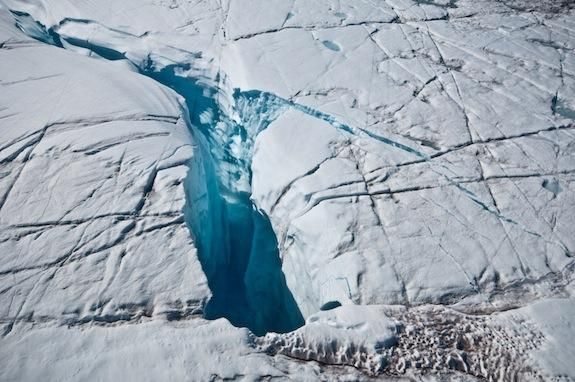Confirmed: Both Antarctica and Greenland Are Losing Ice
After decades of uncertainty, a new study confirms that both polar ice sheets are melting
/https://tf-cmsv2-smithsonianmag-media.s3.amazonaws.com/filer/20121129010204ice-melt-glacier-small.jpg)
Over the past few years, one of the most difficult pieces of evidence to fit into the climate change puzzle has been ice melt. Although the amount of ice covering the Arctic has clearly decreased over time, climate change skeptics have pointed to inconsistent findings on Antarctic ice as proof that the atmosphere isn’t really warming.
Today, with the United Nation’s COP 18 climate negotiations underway in Qatar, a comprehensive study published in Science provides a timely confirmation: The ice sheets covering both Greenland and Antarctica are steadily shrinking, losing roughly 344 billion tons per year in total. Using data from 10 different satellite missions, an international team of 47 scientists has generated a new estimate for ice loss that is more than twice as accurate as previous models, and indicates that the last 20 years of melting at the poles has caused sea level to increase by 11.1 millimeters worldwide since 1992.
“Our new estimates of ice sheet losses are the most reliable to date, and they do provide the clearest evidence yet of polar ice sheet losses,” Andrew Shepherd of the University of Leeds, the study’s lead author, said in a press call. “They also end 20 years of uncertainty concerning changes in the mass of the Antarctic and Greenland ice sheets, and they’re intended to become the benchmark dataset for climate scientists to use from now on.”

Those 20 years of uncertainty are the result of several difficulties inherent in measuring ice melt. Relative to the overall size of the ice sheets, the potential change scientists have been attempting to measure is tiny—on the order of 1 part in 100,000—so sampling errors have led to numbers that vary widely. Gains and losses of ice can also vary from year to year, and from place to place within the same ice sheet. Additionally, the natural seasonal cycle in which sheets add ice during the winter and shed it during the summer makes it even harder to pinpoint the net change over time.
To resolve these difficulties, the researchers assimilated data produced using several different satellite techniques. In one, a satellite in orbit is used to point a laser at glacial ice; the time it takes for the light to bounce back to the satellite indicates the glacier’s precise height, allowing scientists to determine its volume. As part of another technique, a pair of satellites passing over the poles measure the subtle tug of gravity caused by the ice sheets’ mass, and chart the change in the force of this gravity over time.
This data was combined with information collected by regional field surveys and existing climate models that estimate changes in ice cover based on measured precipitation rates and temperature. Despite the variation between years and particular locations, the researchers found that the satellite data fit well with the models’ predictions, and confirmed the hypothesis that as a whole, both ice caps are melting.
The new estimates are that, from 2005 to 2010, Greenland lost roughly 263 billion tons of ice per year, while Antarctica lost 81 billion tons annually. Each year, all this melting causes about 0.6 millimeters of sea level rise. Most alarmingly, both of these ice sheets are melting three times faster than they were in the 1990s.
The melting of the ice caps is troubling as an indicator of the planet’s overall warming, but it could also be problematic in itself, in ways that are both obvious and counterintuitive. For one, sea level rise is a direct threat to both human populations and natural ecosystems along the coasts, as starkly illustrated by Hurricane Sandy and other storms over the past year.
Less obvious is that, according to a study published last month, melting Greenlandic ice could change the salinity of the North Atlantic enough to alter weather patterns in North America and affect aquatic wildlife. By reducing water circulation overall, it could even lead to less carbon dioxide being absorbed into the oceans from the atmosphere, ultimately serving as a positive feedback loop that accelerates climate change.
Of course, finding evidence that the climate is changing has been far easier than coming to international agreements about how to stop it. Scientists can refute the arguments used by climate change skeptics, but if the COP 18 negotiations accomplish as little as most expect, all the data in the world won’t change the fact that it’s uncontrollably warming.
/https://tf-cmsv2-smithsonianmag-media.s3.amazonaws.com/accounts/headshot/joseph-stromberg-240.jpg)
/https://tf-cmsv2-smithsonianmag-media.s3.amazonaws.com/accounts/headshot/joseph-stromberg-240.jpg)